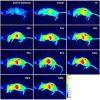Manufacture of IRDye800CW-coupled Fe3O4 nanoparticles and their applications in cell labeling and in vivo imaging
- PMID: 21034487
- PMCID: PMC2984479
- DOI: 10.1186/1477-3155-8-25
Manufacture of IRDye800CW-coupled Fe3O4 nanoparticles and their applications in cell labeling and in vivo imaging
Abstract
Background: In recent years, near-infrared fluorescence (NIRF)-labeled iron nanoparticles have been synthesized and applied in a number of applications, including the labeling of human cells for monitoring the engraftment process, imaging tumors, sensoring the in vivo molecular environment surrounding nanoparticles and tracing their in vivo biodistribution. These studies demonstrate that NIRF-labeled iron nanoparticles provide an efficient probe for cell labeling. Furthermore, the in vivo imaging studies show excellent performance of the NIR fluorophores. However, there is a limited selection of NIRF-labeled iron nanoparticles with an optimal wavelength for imaging around 800 nm, where tissue autofluorescence is minimal. Therefore, it is necessary to develop additional alternative NIRF-labeled iron nanoparticles for application in this area.
Results: This study manufactured 12-nm DMSA-coated Fe3O4 nanoparticles labeled with a near-infrared fluorophore, IRDye800CW (excitation/emission, 774/789 nm), to investigate their applicability in cell labeling and in vivo imaging. The mouse macrophage RAW264.7 was labeled with IRDye800CW-labeled Fe3O4 nanoparticles at concentrations of 20, 30, 40, 50, 60, 80 and 100 μg/ml for 24 h. The results revealed that the cells were efficiently labeled by the nanoparticles, without any significant effect on cell viability. The nanoparticles were injected into the mouse via the tail vein, at dosages of 2 or 5 mg/kg body weight, and the mouse was discontinuously imaged for 24 h. The results demonstrated that the nanoparticles gradually accumulated in liver and kidney regions following injection, reaching maximum concentrations at 6 h post-injection, following which they were gradually removed from these regions. After tracing the nanoparticles throughout the body it was revealed that they mainly distributed in three organs, the liver, spleen and kidney. Real-time live-body imaging effectively reported the dynamic process of the biodistribution and clearance of the nanoparticles in vivo.
Conclusion: IRDye800CW-labeled Fe3O4 nanoparticles provide an effective probe for cell-labeling and in vivo imaging.
Figures








Similar articles
-
Near-infrared fluorescence labeling of iron nanoparticles and applications for cell labeling and in vivo imaging.Methods Mol Biol. 2012;906:221-37. doi: 10.1007/978-1-61779-953-2_17. Methods Mol Biol. 2012. PMID: 22791436
-
Dual-Modality Image-Guided Surgery of Prostate Cancer with a Radiolabeled Fluorescent Anti-PSMA Monoclonal Antibody.J Nucl Med. 2014 Jun;55(6):995-1001. doi: 10.2967/jnumed.114.138180. Epub 2014 Apr 3. J Nucl Med. 2014. PMID: 24700882
-
Triple-modal imaging of stem-cells labeled with multimodal nanoparticles, applied in a stroke model.World J Stem Cells. 2019 Feb 26;11(2):100-123. doi: 10.4252/wjsc.v11.i2.100. World J Stem Cells. 2019. PMID: 30842808 Free PMC article.
-
Site-Specific Fluorescent Labeling of Antibodies and Diabodies Using SpyTag/SpyCatcher System for In Vivo Optical Imaging.Mol Imaging Biol. 2019 Feb;21(1):54-66. doi: 10.1007/s11307-018-1222-y. Mol Imaging Biol. 2019. PMID: 29948640
-
In vivo near-infrared fluorescence imaging of cancer with nanoparticle-based probes.Wiley Interdiscip Rev Nanomed Nanobiotechnol. 2010 Jul-Aug;2(4):349-66. doi: 10.1002/wnan.85. Wiley Interdiscip Rev Nanomed Nanobiotechnol. 2010. PMID: 20564463 Review.
Cited by
-
Multimodality Imaging of Angiogenesis in a Rabbit Atherosclerotic Model by GEBP11 Peptide Targeted Nanoparticles.Theranostics. 2017 Oct 17;7(19):4791-4804. doi: 10.7150/thno.20767. eCollection 2017. Theranostics. 2017. PMID: 29187904 Free PMC article.
-
Inorganic-organic hybrid nanomaterials for therapeutic and diagnostic imaging applications.Int J Mol Sci. 2011;12(6):3888-927. doi: 10.3390/ijms12063888. Epub 2011 Jun 10. Int J Mol Sci. 2011. PMID: 21747714 Free PMC article. Review.
-
State of the Art in Prostate-specific Membrane Antigen-targeted Surgery-A Systematic Review.Eur Urol Open Sci. 2023 Jun 16;54:43-55. doi: 10.1016/j.euros.2023.05.014. eCollection 2023 Aug. Eur Urol Open Sci. 2023. PMID: 37361200 Free PMC article. Review.
-
A novel method to quantify IRDye800CW fluorescent antibody probes ex vivo in tissue distribution studies.EJNMMI Res. 2012 Sep 25;2(1):50. doi: 10.1186/2191-219X-2-50. EJNMMI Res. 2012. PMID: 23009555 Free PMC article.
References
-
- Tiefenauer L. In: Nanotechnology in Biology and Medicine. Tuan Vo-Dinh, editor. Boca Raton: CRC Press; 2007. Magnetic Nanoparticles as Contrast Agents for Medical Diagnosis. 29/10.
LinkOut - more resources
Full Text Sources
Miscellaneous

